人教新目标九年级英语第十二单元课件 Unit 12 Life is full of the unexpected(共38张PPT)
文档属性
| 名称 | 人教新目标九年级英语第十二单元课件 Unit 12 Life is full of the unexpected(共38张PPT) | 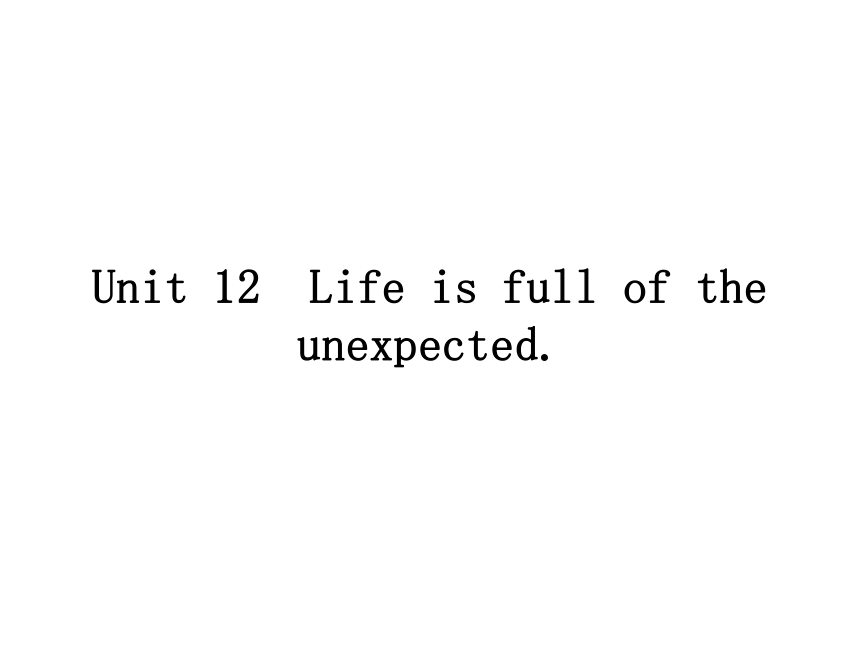 | |
| 格式 | zip | ||
| 文件大小 | 125.5KB | ||
| 资源类型 | 教案 | ||
| 版本资源 | 人教新目标(Go for it)版 | ||
| 科目 | 英语 | ||
| 更新时间 | 2015-05-01 22:00:51 | ||
图片预览

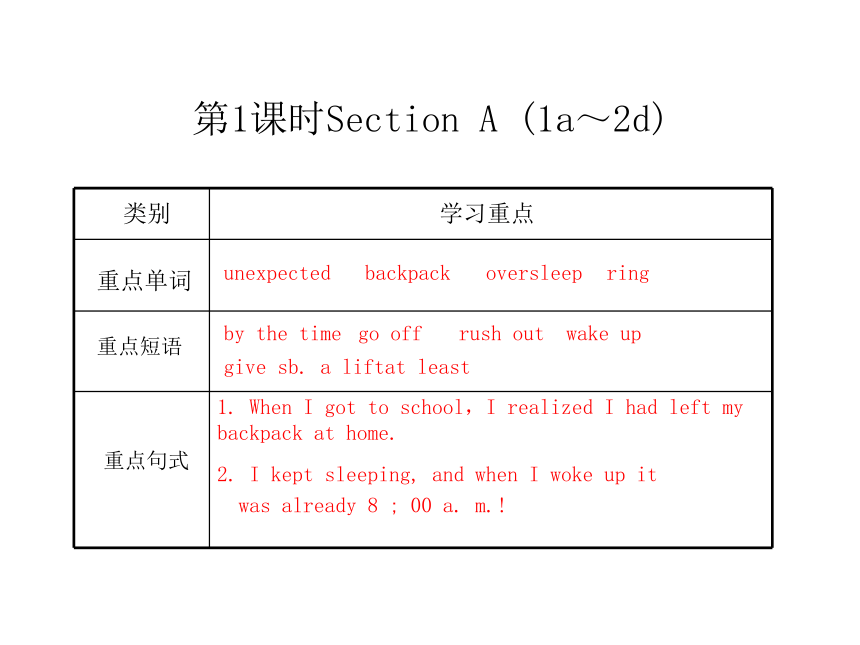
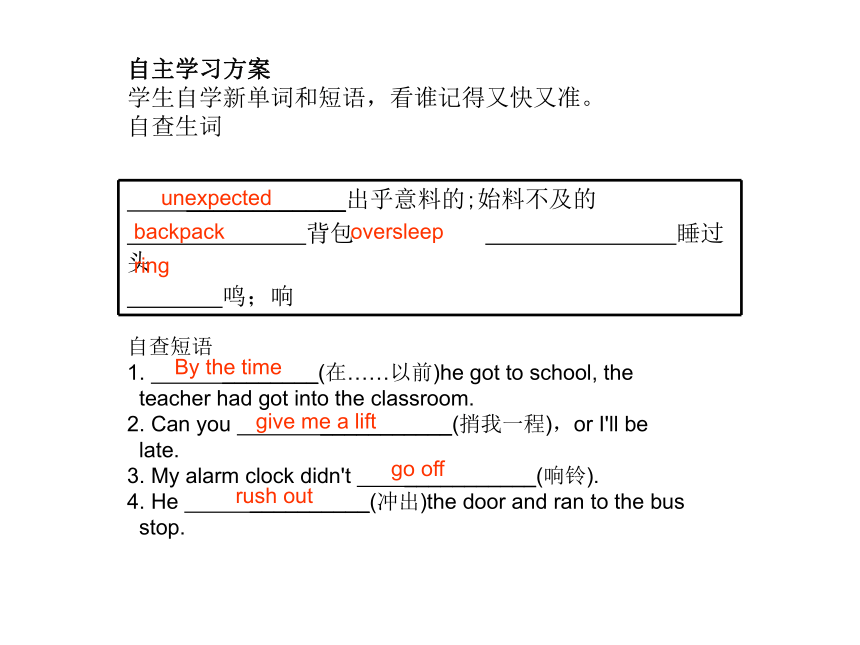
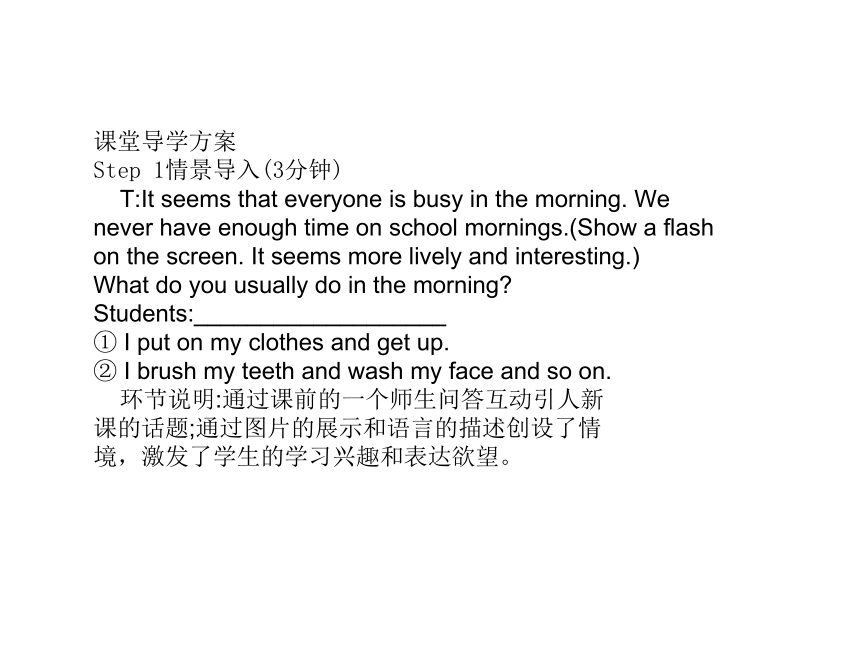
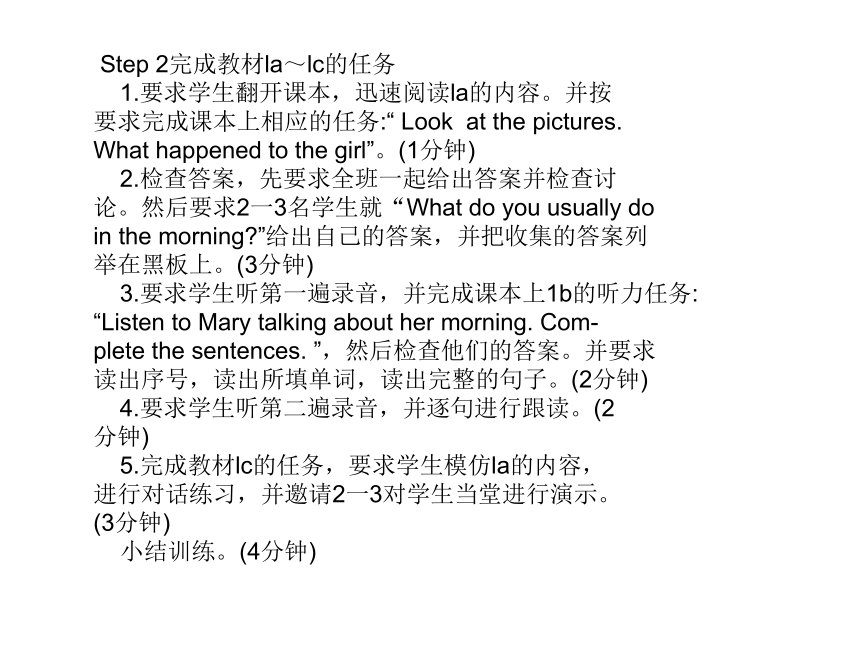
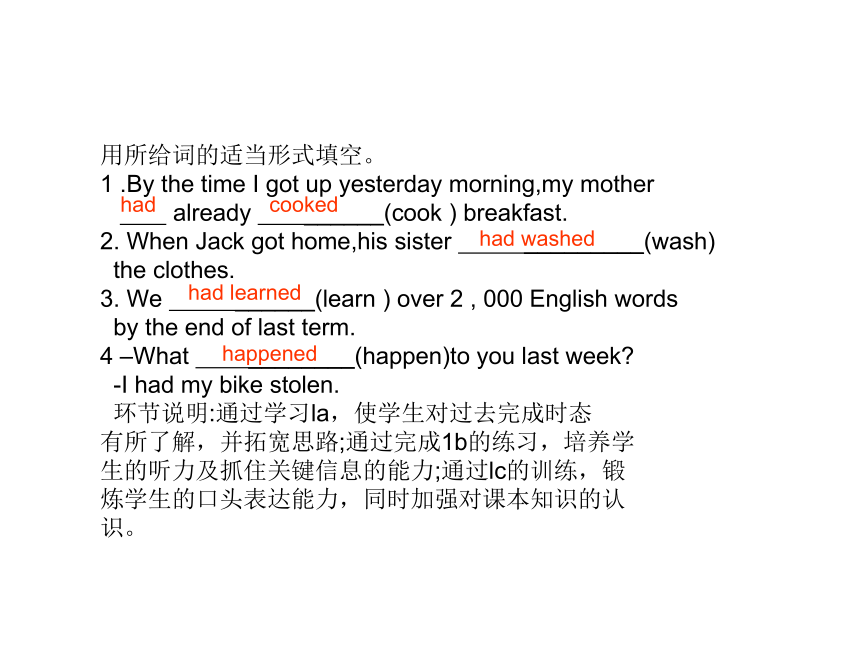
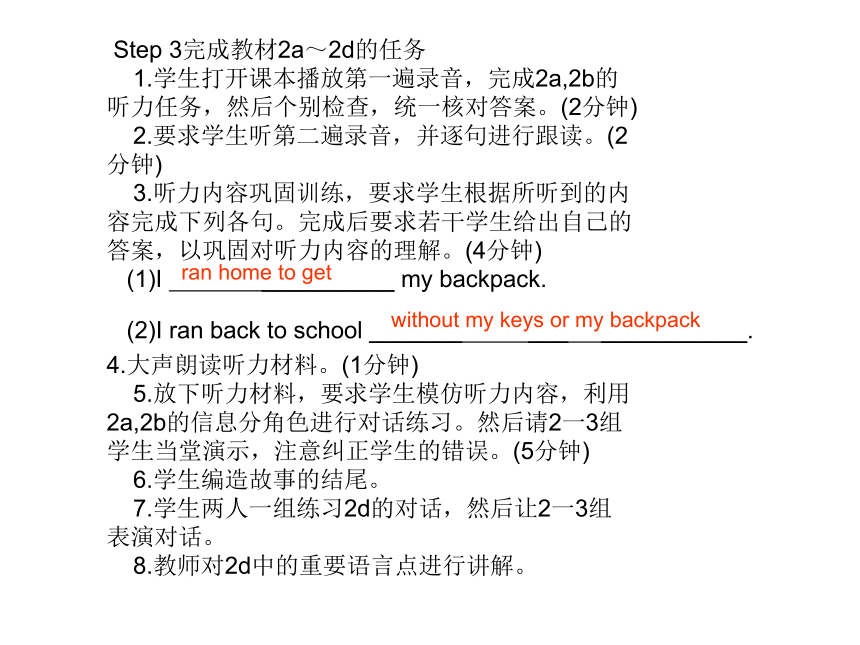
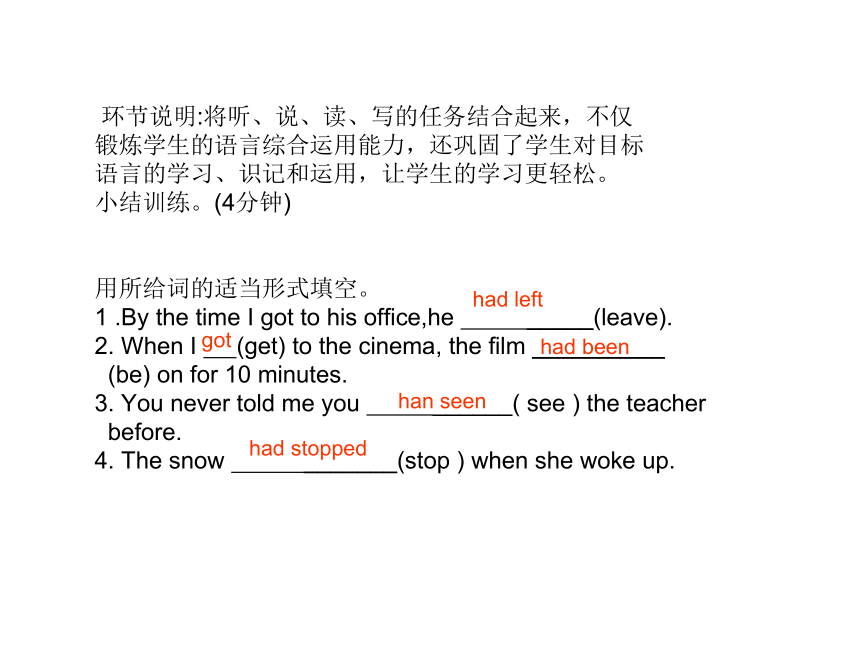
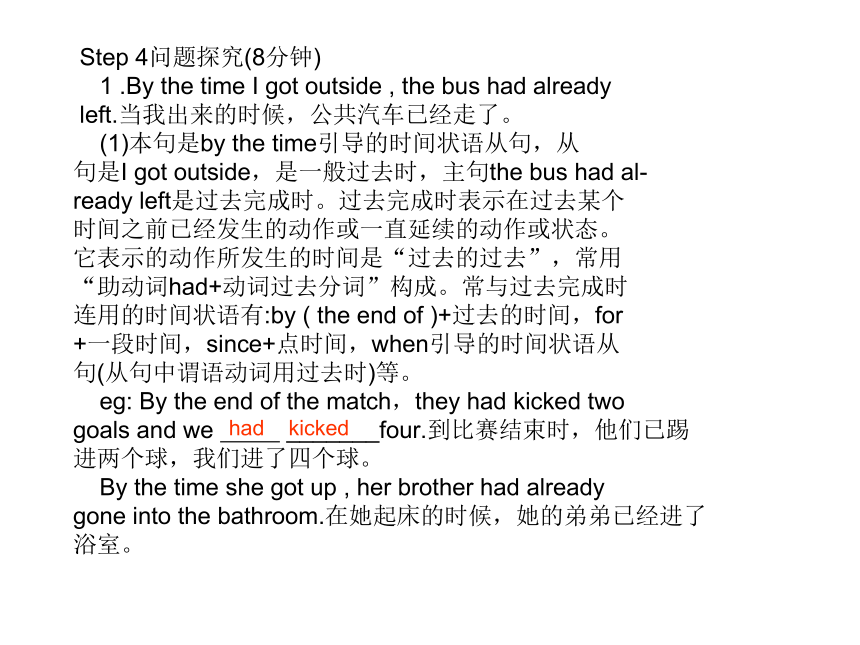
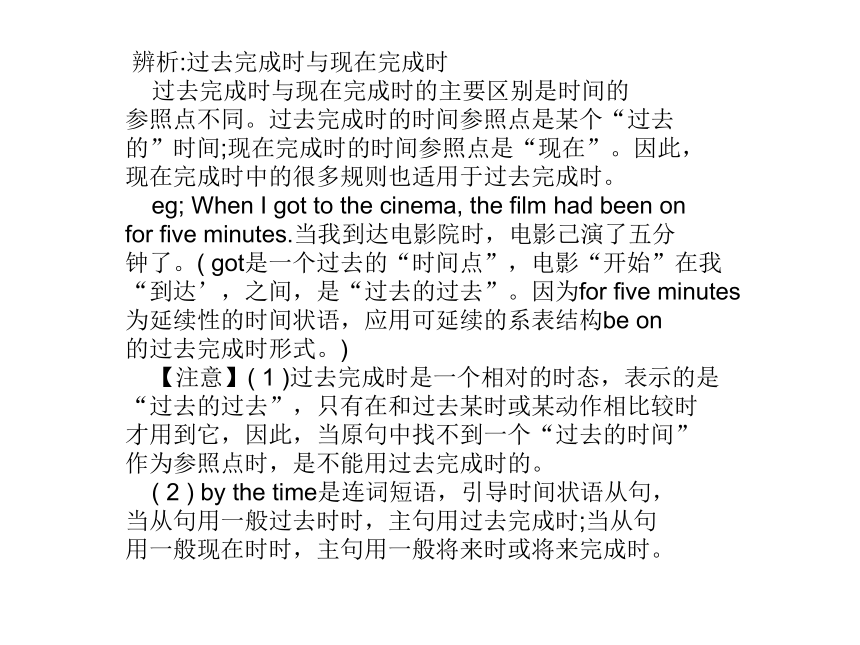
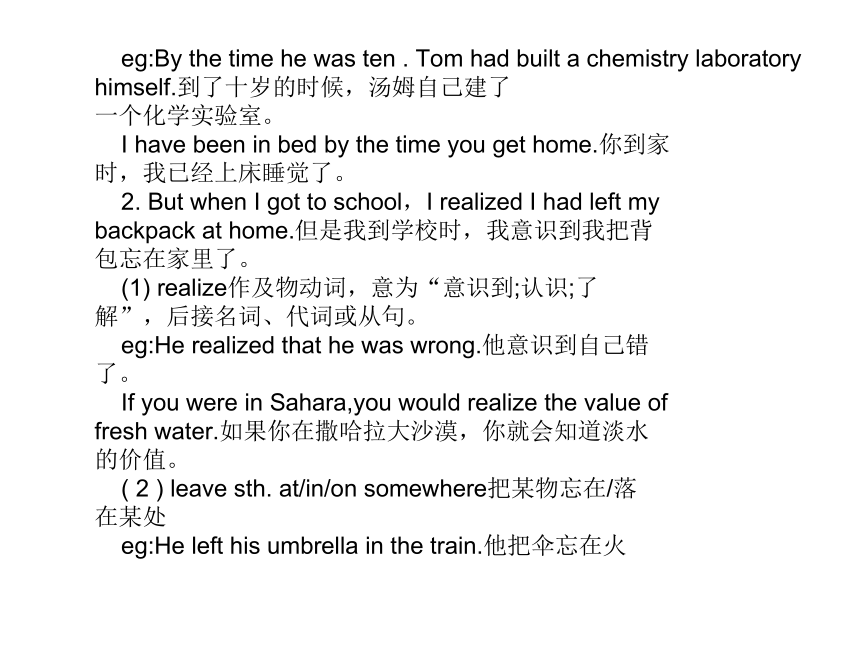
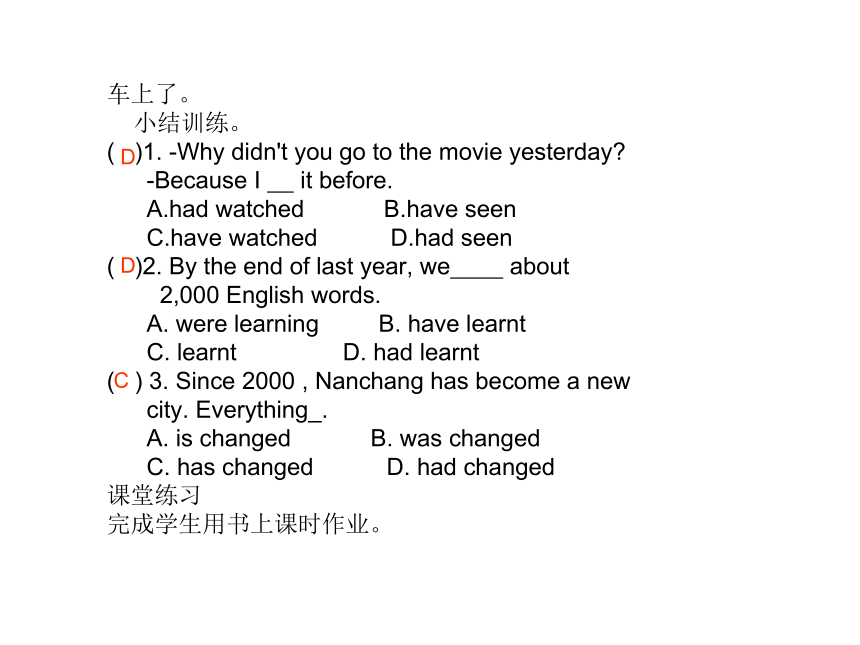
文档简介
课件38张PPT。Unit 12 Life is full of the unexpected.
第1课时Section A (1a~2d)类别学习重点重点单词unexpectedbackpackoversleepring重点短语重点句式by the time give sb. a lift go off rush out wake upat least1. When I got to school,I realized I had left my backpack at home.2. I kept sleeping, and when I woke up it
was already 8 ; 00 a. m.!自主学习方案 学生自学新单词和短语,看谁记得又快又准。 自查生词 自查短语
1. ________(在……以前)he got to school, the
teacher had got into the classroom.
2. Can you ___________(捎我一程),or I'll be
late.
3. My alarm clock didn't ___________(响铃).
4. He __________(冲出)the door and ran to the bus
stop.
unexpectedbackpackoversleepringBy the timegive me a liftgo offrush out 课堂导学方案 Step 1情景导入(3分钟) T:It seems that everyone is busy in the morning. We never have enough time on school mornings.(Show a flash on the screen. It seems more lively and interesting.) What do you usually do in the morning? Students:___________________ ① I put on my clothes and get up. ② I brush my teeth and wash my face and so on. 环节说明:通过课前的一个师生问答互动引人新 课的话题;通过图片的展示和语言的描述创设了情 境,激发了学生的学习兴趣和表达欲望。 Step 2完成教材la~lc的任务 1.要求学生翻开课本,迅速阅读la的内容。并按 要求完成课本上相应的任务:“ Look at the pictures. What happened to the girl”。(1分钟) 2.检查答案,先要求全班一起给出答案并检查讨 论。然后要求2一3名学生就“What do you usually do in the morning?”给出自己的答案,并把收集的答案列 举在黑板上。(3分钟) 3.要求学生听第一遍录音,并完成课本上1b的听力任务: “Listen to Mary talking about her morning. Com- plete the sentences. ”,然后检查他们的答案。并要求 读出序号,读出所填单词,读出完整的句子。(2分钟) 4.要求学生听第二遍录音,并逐句进行跟读。(2 分钟) 5.完成教材lc的任务,要求学生模仿la的内容, 进行对话练习,并邀请2一3对学生当堂进行演示。 (3分钟) 小结训练。(4分钟) 用所给词的适当形式填空。 1 .By the time I got up yesterday morning,my mother already ______(cook ) breakfast. 2. When Jack got home,his sister _________(wash) the clothes. 3. We ______(learn ) over 2 , 000 English words by the end of last term. 4 –What ________(happen)to you last week? -I had my bike stolen. 环节说明:通过学习la,使学生对过去完成时态 有所了解,并拓宽思路;通过完成1b的练习,培养学 生的听力及抓住关键信息的能力;通过lc的训练,锻 炼学生的口头表达能力,同时加强对课本知识的认 识。 hadcookedhad washedhad learnedhappened Step 3完成教材2a~2d的任务 1.学生打开课本播放第一遍录音,完成2a,2b的 听力任务,然后个别检查,统一核对答案。(2分钟) 2.要求学生听第二遍录音,并逐句进行跟读。(2 分钟) 3.听力内容巩固训练,要求学生根据所听到的内 容完成下列各句。完成后要求若干学生给出自己的 答案,以巩固对听力内容的理解。(4分钟) (1)I __________ my backpack. (2)I ran back to school _______ ___ ___________. 4.大声朗读听力材料。(1分钟) 5.放下听力材料,要求学生模仿听力内容,利用 2a,2b的信息分角色进行对话练习。然后请2一3组 学生当堂演示,注意纠正学生的错误。(5分钟) 6.学生编造故事的结尾。 7.学生两人一组练习2d的对话,然后让2一3组 表演对话。 8.教师对2d中的重要语言点进行讲解。 ran home to getwithout my keys or my backpack 环节说明:将听、说、读、写的任务结合起来,不仅 锻炼学生的语言综合运用能力,还巩固了学生对目标 语言的学习、识记和运用,让学生的学习更轻松。 小结训练。(4分钟) 用所给词的适当形式填空。 1 .By the time I got to his office,he _____(leave). 2. When I (get) to the cinema, the film __________ (be) on for 10 minutes. 3. You never told me you ______( see ) the teacher before. 4. The snow _______(stop ) when she woke up.had leftgothad beenhan seenhad stopped Step 4问题探究(8分钟) 1 .By the time I got outside , the bus had already left.当我出来的时候,公共汽车已经走了。 (1)本句是by the time引导的时间状语从句,从 句是I got outside,是一般过去时,主句the bus had al- ready left是过去完成时。过去完成时表示在过去某个 时间之前已经发生的动作或一直延续的动作或状态。 它表示的动作所发生的时间是“过去的过去”,常用 “助动词had+动词过去分词”构成。常与过去完成时 连用的时间状语有:by ( the end of )+过去的时间,for +一段时间,since+点时间,when引导的时间状语从 句(从句中谓语动词用过去时)等。 eg: By the end of the match,they had kicked two goals and we _______four.到比赛结束时,他们已踢 进两个球,我们进了四个球。 By the time she got up , her brother had already gone into the bathroom.在她起床的时候,她的弟弟已经进了 浴室。 had kicked 辨析:过去完成时与现在完成时 过去完成时与现在完成时的主要区别是时间的 参照点不同。过去完成时的时间参照点是某个“过去 的”时间;现在完成时的时间参照点是“现在”。因此, 现在完成时中的很多规则也适用于过去完成时。 eg; When I got to the cinema, the film had been on for five minutes.当我到达电影院时,电影己演了五分 钟了。( got是一个过去的“时间点”,电影“开始”在我 “到达’,之间,是“过去的过去”。因为for five minutes 为延续性的时间状语,应用可延续的系表结构be on 的过去完成时形式。) 【注意】( 1 )过去完成时是一个相对的时态,表示的是 “过去的过去”,只有在和过去某时或某动作相比较时 才用到它,因此,当原句中找不到一个“过去的时间” 作为参照点时,是不能用过去完成时的。 ( 2 ) by the time是连词短语,引导时间状语从句, 当从句用一般过去时时,主句用过去完成时;当从句 用一般现在时时,主句用一般将来时或将来完成时。 eg:By the time he was ten . Tom had built a chemistry laboratory himself.到了十岁的时候,汤姆自己建了 一个化学实验室。 I have been in bed by the time you get home.你到家 时,我已经上床睡觉了。 2. But when I got to school,I realized I had left my backpack at home.但是我到学校时,我意识到我把背 包忘在家里了。 (1) realize作及物动词,意为“意识到;认识;了 解”,后接名词、代词或从句。 eg:He realized that he was wrong.他意识到自己错 了。 If you were in Sahara,you would realize the value of fresh water.如果你在撒哈拉大沙漠,你就会知道淡水 的价值。 ( 2 ) leave sth. at/in/on somewhere把某物忘在/落 在某处 eg:He left his umbrella in the train.他把伞忘在火车上了。 小结训练。 ( )1. -Why didn't you go to the movie yesterday? -Because I it before. A.had watched B.have seen C.have watched D.had seen ( )2. By the end of last year, we about 2,000 English words. A. were learning B. have learnt C. learnt D. had learnt ( ) 3. Since 2000 , Nanchang has become a new city. Everything_. A. is changed B. was changed C. has changed D. had changed 课堂练习 完成学生用书上课时作业。DDC 第2课时Section A (3a~4c) 自主学习方案 学生自学新单词和短语,看谁记得又快又准。 自查生词 自查短语
1.Your friend called me to say he ________(将
要)come to our home.
2. We must _________(站队等候),or others will
be mad.
3. Why are you ____________(用怀疑地眼光盯着我)?
4. He ____________________(从……跳下)bed and rushed
out the door without breakfast.blockworkerstareaboveburnaliveairporttill
was about towait in linestare at me in disbeliefjumped out of 课堂导学方案 Step 1情景导入(3分钟) (1)T; Our life is full of the unexpected. Do you re- member some unexpected events in our country/city/ town/about yourself? Who can tell the story and let us share the event For example:Do you remember the terror event in Xingjiang, the flight MH370 event or New York World Trade Centers Of course you may remember your own bad/unlucky thing. Please tell us about it. (2)Today we will read some unexpected events/ things. Let’s read these events/things and answer these questions. Question: 1 .When did the first event happen? ___________________________________________ 2. What was the writer doing at that time? ___________________________________________ 3. What happened to the writer 10 years later? ___________________________________________ 4. At last how did the writer feel? ________________________________ 环节说明:通过带着问题去学习短文,从而达到 导入新课的目的。 Step 2完成教材3a~3c的任务 1.要求学生快速默读短文,熟知大意,并完成课 本3a的任务,几位学生给出自己的答案,全班一起检 查讨论。(3分钟) 2.先请几位学生阅读短文(可一人一段),教师要 注意学生的语音,及时纠正。然后播放录音,全班学 生一起跟读。(3分钟) 3.短文内容巩固练习。教师可给出一篇改写了 的短文,将一些重点的表达方式空出,让学生在规定 的时间内补全短文,然后邀请若干学生给出自己的答 案。(4分钟) 4.完成教材3b的任务。从3a中找出3b中那些 形容词的反义词。(5分钟) 5.学生阅读短文10分钟,看谁能讲出短文中的任 何一个故事,可以参考3c中的单词和短语。 环节说明:将读、写的任务结合起来,不仅锻炼了 学生的语言综合运用能力,还巩固了学生对过去完成 时态的学习和运用,安排好自己的时间,学会生活。 小结训练。(4分钟) 根据汉语提示完成句子。 1.他们怀疑地盯着那升起的黑烟。 They disbelief the black smoke . 2.飞机到上午11点才起飞。 The plane didn’t 11: 00 a. m. 3.坏事将会变成好事。 The bad thing is to a good thing. stared inatrisingtake off tillaboutturn into Step 3完成教材Granunar Focus~4c的任务 1.让学生阅读Grammar Focus中的句子,引导学 生归纳语法知识。(可参考学案中《单元语法归纳与 精练》,并完成相应的练习。) 2.学生独立完成4a~4c的任务。 Step 4 job题探究(3分钟) 1. stare at盯着……看 eg : He’s staring at the disabled man. It’s impolite. 他正盯着那残疾人看,不礼貌。 2. show up出席;赶到;露面 show up相当于appearo eg : We waited for two hours , but he didn’t show up. 我们等了两个小时,但他一直没露面。 3. look at看着…… eg : Please look at the blackboard , and I'll tell you the reason.请看黑板,我将告诉你们原因。 课堂练习 完成学生用书上课时作业。 第3课时Section B (1a~1e) 自主学习方案 学生自学新单词和短语,看谁记得又快又准。 自查生词 自查短语
1.He is old enough to (穿衣服).
2. Don't (熬夜),or you will feel sleepy in
class tomorrow.
3. Would you like to go to the (化装
舞会)?
4. He won't (出现)because today is Sunday.foolcostumeembarrassedget dressedstay upcostume partyshow up 课堂导学方案 Step 1情景导入(2分钟) 回顾:在前面的课程中我们已经学习并了解了用 过去完成时态叙述过去发生的事情。下面提几个简 单问题来回顾上节课的内容。 Questions: 1.Have you ever locked your keys in your house? _____________________________________________ 2.What happened to you that day? _____________________________________________ 3.Did you get into your house finally? _____________________________________________ 环节说明:课前的师生问答互动不仅让学生回顾 了上节课的内容,引导他们复习过去时态和过去完成 时态,同时,让他们知道生活中的不如意可以通过自 己的努力来改变,而且还可以很自然地导人到本节课 的内容。 Step 2完成教材la~1e的任务 1.要求学生翻开课本,迅速阅读la的内容。并按 要求完成课本上相应的任务,然后要求学生给出自己 的答案,并进行个读,齐读。(4分钟) 2.要求学生完成1b的任务:“ Tell your partner a- bout something that happened to you recently. Use two or more words in 1 a.”。 3.听第一遍录音,完成课本上lc的任务:“ Listen and write each person's name under the correct picture.”。 (2分钟) 4.听第二遍录音,完成课本1d的任务:“ Listen a- gain. Who says each of the phrases below? Write D,N or J.”。检查他们的答案,然后大声地朗读。(2分钟) 5.听力内容巩固训练。要求学生根据所听到的内容完成下列对话。完成后要求若干学生给出自己的答案,以巩固对听力内容的理解。(3分钟) (1)Dave:A friend once him _____________________ . When he got there,he that his friend him. He was a costume. He was really . (2)Nick: When his alarm ,he got up , took a shower, ,and went to school. But when he got there , the school was . After an hour , the other kids ,and he realized that his brother ___________ the clock . (3)Joe:On March 31 st last year, his friend called and told him they had a test . By the time he got to math class,he was because he _______________ all night studying. Then he that they didn’t have a test at all.invitedto a costume partyfoundhad fooledthe only person wearingembarrassedwent offgot dressedemptyshowed uphad changedto an hour earlierthe next daytiredhad stayed upfound out 6.听第三遍录音,并打开听力材料,全班逐句进 行跟读。 7.放下听力材料,要求学生模仿听力内容,利用 lc,ld的信息分角色进行对话练习。然后请2~3对 学生当堂演示,看哪一对的表现最佳。(5分钟) 环节说明:将听、说、读、写的任务结合起来,不仅 锻炼了学生的语言综合运用能力,还巩固了学生对目 标语言的学习、识记和运用;幽默十足的故事让学生 体验到学英语的乐趣。 小结训练。(5分钟) 用所给词的适当形式填空。 1.Zhang Kai (stay ) up all night last Mon- day. 2. What do you do on April (fool) Day? 3. Did you invite Kangkang (have)dinner? 4. The boy can get (dress) now. stayedFool’sto havedressed Step 3问题探究(6分钟) 1. empty的用法 (1)作形容词,意为“空的;空闲的”,常作表语或 定语,此时其反义词是full o eg: We walked in the empty street.我们走在空旷的 街上。 The bottle is empty.瓶子是空的。 (2)作动词,意为“排空;倒出”,后常接宾语,此时 其反义词为fill o eg:He emptied his tool bag.他倒空了他的工具袋。 She emptied the box.她倒空了箱子。 2. Last Friday night, my friend invited me to his birthday party…上周五晚上,我朋友邀请我参加他的 生日晚会…… invite sb. to+某地方或某一活动(聚会),意为 “邀请某人到某地方或参加某一活动”;而invite sb. to do sth.意为“邀请某人做某事”。 eg: I think we have many friends now, and we should invite them to our homes.我想我们现在有很多朋友了, 我们应该邀请他们到我们家做客。 Kitty’s teacher Mr. Wu invited me to join their school travel to the World Park.基蒂的老师吴老师邀请 我参加了去世界公园的学校郊游活动。 小结训练。 (1)本次会议,我们将邀请多少人? How many people shall we invite to the meeting? (2)我邀请她出去散散步。 I invite旦her to go out for a walk. 3. the other kids showed up其他孩子出现了 show up意为“出席;露面’,。 eg : He didn‘ t show up till 9 ; 00.他直到九点才露 面。 [拓展]与show构成的常用短语有: show sb. sth. = show sth. to sb.给某人看某物 show sb.around带领某人参观…… show off炫耀 on show展览 小结训练。( )-It is said that Jay Chou sang his latest song in the concert. -That‘s impossible. In fact,he had never _by the time the concert ended. A. put up B. set up C. fixed up D. shown up 4.happen的用法 (1)happen是不及物动词,意为“发生”。不可用 于被动语态中。 eg:Do you know what happened last night?你知道 昨晚发生了什么事吗? (2) happen to sb.某事发生在某人身上 eg:A car accident happened to his English teacher this morning.今天早晨他的英语老师出车祸了。D (3)happen to do sth.碰巧做某事 eg:He happened to meet Lucy in the street just now. 他刚刚在街上碰巧遇见露西了。 小结训练。 (1)He (碰巧)see the accident. (2)When the earthquake (发生)? 课堂练习案 完成学生用书上课时作业。happened todidhappen 第4课时Section B (2a~3b) 自主学习方案 学生自学新单词和短语,看谁记得又快又准。 自查生词 自查短语
1.People ___________(愚弄)each other on April
Fool's Day.
2.I didn't know the kind of mobile phones had been
(卖完).
3.The party _______(以……结束)being not very
funny.
4.Who did he ____________(娶)?
5.We will _______(用完)energy on the earth.
announcehoaxdiscoveryladycancelofficerdisappearbelievableplay jokes on sold outended upget married torun out of 课堂导学方案 Step 1情景导入(2分钟) T:Do you know about April Fool’s Day? What do people in the Western country do on April Fool’s Day? Maybe you know they play tricks and jokes on each other so that they have fun. But not all April Fool’s jokes end up being very funny. If you read the passage,you can know about it. 环节说明:教师的导入激起学生的学习兴趣,也 便于学生对文章的理解。 Step 2完成教材2a~2e的任务 1.完成2a的任务。(看谁能讲述愚人节发生的 故事) 2.要求学生快速默读短文,熟知大意,并完成课 本2b的任务。(将方框中的段落中心句与文章的各 段匹配)(3分钟) 3.先邀请几位学生阅读短文(可一人一段),教师 要注意学生的语音,给予必要的朗读指导。然后播放 录音,全班学生一起跟读。(3分钟) 4.读短文,回答2c中的问题,教师纠正答案。 5.再读短文,完成2d的填词任务。 6.短文内容巩固练习。教师可给出一篇改写了 的短文,将一些重点的表达方式空出,让学生在规定 的时间内补全短文,然后邀请若干学生给出自己的答 案。(4分钟) 7.学生两人一组完成2e的任务。(根据学生的 实际情况讲真实的故事) 8.让2~3组学生表演他们的对话。 小结训练。(3分钟)用所给词的适当形式填空 1.They have been (marry) for two years. 2. I love to see movies that have a happy ________(end). 3. The hoax isn’t __________( believe ). 4. Stars _______(appear) in the daytime and appear at night. 5. The party ended up ___________( sing ) a birthday song. 6. What’s Chinese new __________(discover)in 2015? Step 3完成教材3a一3b的任务 1.以小组为单位,列出小组成员所经历的幸运/不幸运的一天,作好笔记。(5分钟) 2.学生根据3b的要求,用3a的信息写作文。 3.参考学案上《单元写作指导》,并完成本单元的写作内容。 marriedendingbelievabledisappearsingingdiscovery Step 4 job题探究(10分钟) 1.marry:.嫁;娶;与……结婚 marry常用于以下结构: ( 1 ) A marry B意为“A与B结婚;A娶/嫁给B”。 eg:Jane is going to marry John.简就要嫁给约翰了。 ( 2 ) A and B get married=A and B are married=A be/get married to B意为“A和B结婚”。 eg:Lucy and Leo got married last week.露西和利奥 上周结婚了。 ( 3 ) marry A to B意为“A嫁给B或B娶了A”。 eg:He married his son to a rich girl.他给儿子娶了 一个有钱的女子。 【拓展】( 1 ) marry为短暂性动词,在肯定句中不能 与表示一段时间的状语连用。be married是系表结 构,表示状态,可以和表示一段时间的状语连用。 eg:They got married three years ago.=They have been married for three years.=It has been three years since they got married.他们结婚三年了。 ( 2 ) married作表语时介词要用to,不用with,即 be/get married to sb.。 eg; Willis was married to Della in 2013. 2013年威 利斯和黛拉结婚了。 2. sell out卖完;售光 eg;This kind of shoes are sold out.这种鞋子卖完 了。 The books you ask for are all sold out.你要的书都 卖完了。 [拓展]sale n.出售;销售。n sale降价销售 3. so...that…引导结果状态从句,so后面应接一个 形容词或副词,意为“如此··…以致于……”。 eg:This book is so interesting that everyone in our class wants to read it.这本书是如此有趣以致于全班每个人 都想看看。(so+形容词) He ran so fast that I couldn’t catch up with him.他 跑得那么快,以致于我跟不上他。( so+副词) 【拓展】表示“如此……以致于……”之意时,SO...that …句型可与too ... to do sth. , enough to do sth.这两 个结构可互换使用。 (1)在,o...that…句型中,当主句和从句都是肯定 句时,且主、从句的主语指的是同一人时,可简化为 enough to do sth.结构。 eg: He ran so fast that he caught up with us quickly. =He ran fast enough to catch up with us quickly.他跑得 飞快,很快就赶上了我们。 (2)在,o...that…句型中,当主句和从句都是肯定 句时,但主、从句的主语不一致时,可简化成enough for sb.to do sth.结构。 eg:The problem is so easy that she can work it out. =The problem is easy enough for her to work out.这道题 很容易,她能解答出来。 (3)在so...that…句型中,当主句和从句的主语一 致,但主句是肯定句,从句是否定句时,可简化成 enough to do sth.或too...to do sth.结构。与enough to do sth.转换时,形容词或副词应变为相反的词,前面的 动词为否定形式。 eg:He is so young that he can’t go to school.=He is too young to go to school.=He is not old enough to go to school.他还没到上学的年龄。 如果主从句的主语不一致,需在to do sth.前加for sb.作为不定式的逻辑主语。 eg:The problem is so difficult that we can’t work it out.=The problem is too difficult for us to work out.= The problem isn’t easy enough for us to work out.这道题 太难了,我们解答不出来。 3. Many people ran to their local supermarkets to buy as much spaghetti as they could.许多人跑到本地超市尽 可能多地购买意大利面条。 as...as one can结构中as...as中间为形容词或副 词原级,也可以用“many+可数名词复数”或“much + 不可数名词”,相当于as...as possible。 eg: We should speak as much English as we can.我 们应当尽可能多地讲英语。 He ran away as quickly as possible.他尽可能快地 逃跑了。 课堂练习 完成学生用书上课时作业。
was already 8 ; 00 a. m.!自主学习方案 学生自学新单词和短语,看谁记得又快又准。 自查生词 自查短语
1. ________(在……以前)he got to school, the
teacher had got into the classroom.
2. Can you ___________(捎我一程),or I'll be
late.
3. My alarm clock didn't ___________(响铃).
4. He __________(冲出)the door and ran to the bus
stop.
unexpectedbackpackoversleepringBy the timegive me a liftgo offrush out 课堂导学方案 Step 1情景导入(3分钟) T:It seems that everyone is busy in the morning. We never have enough time on school mornings.(Show a flash on the screen. It seems more lively and interesting.) What do you usually do in the morning? Students:___________________ ① I put on my clothes and get up. ② I brush my teeth and wash my face and so on. 环节说明:通过课前的一个师生问答互动引人新 课的话题;通过图片的展示和语言的描述创设了情 境,激发了学生的学习兴趣和表达欲望。 Step 2完成教材la~lc的任务 1.要求学生翻开课本,迅速阅读la的内容。并按 要求完成课本上相应的任务:“ Look at the pictures. What happened to the girl”。(1分钟) 2.检查答案,先要求全班一起给出答案并检查讨 论。然后要求2一3名学生就“What do you usually do in the morning?”给出自己的答案,并把收集的答案列 举在黑板上。(3分钟) 3.要求学生听第一遍录音,并完成课本上1b的听力任务: “Listen to Mary talking about her morning. Com- plete the sentences. ”,然后检查他们的答案。并要求 读出序号,读出所填单词,读出完整的句子。(2分钟) 4.要求学生听第二遍录音,并逐句进行跟读。(2 分钟) 5.完成教材lc的任务,要求学生模仿la的内容, 进行对话练习,并邀请2一3对学生当堂进行演示。 (3分钟) 小结训练。(4分钟) 用所给词的适当形式填空。 1 .By the time I got up yesterday morning,my mother already ______(cook ) breakfast. 2. When Jack got home,his sister _________(wash) the clothes. 3. We ______(learn ) over 2 , 000 English words by the end of last term. 4 –What ________(happen)to you last week? -I had my bike stolen. 环节说明:通过学习la,使学生对过去完成时态 有所了解,并拓宽思路;通过完成1b的练习,培养学 生的听力及抓住关键信息的能力;通过lc的训练,锻 炼学生的口头表达能力,同时加强对课本知识的认 识。 hadcookedhad washedhad learnedhappened Step 3完成教材2a~2d的任务 1.学生打开课本播放第一遍录音,完成2a,2b的 听力任务,然后个别检查,统一核对答案。(2分钟) 2.要求学生听第二遍录音,并逐句进行跟读。(2 分钟) 3.听力内容巩固训练,要求学生根据所听到的内 容完成下列各句。完成后要求若干学生给出自己的 答案,以巩固对听力内容的理解。(4分钟) (1)I __________ my backpack. (2)I ran back to school _______ ___ ___________. 4.大声朗读听力材料。(1分钟) 5.放下听力材料,要求学生模仿听力内容,利用 2a,2b的信息分角色进行对话练习。然后请2一3组 学生当堂演示,注意纠正学生的错误。(5分钟) 6.学生编造故事的结尾。 7.学生两人一组练习2d的对话,然后让2一3组 表演对话。 8.教师对2d中的重要语言点进行讲解。 ran home to getwithout my keys or my backpack 环节说明:将听、说、读、写的任务结合起来,不仅 锻炼学生的语言综合运用能力,还巩固了学生对目标 语言的学习、识记和运用,让学生的学习更轻松。 小结训练。(4分钟) 用所给词的适当形式填空。 1 .By the time I got to his office,he _____(leave). 2. When I (get) to the cinema, the film __________ (be) on for 10 minutes. 3. You never told me you ______( see ) the teacher before. 4. The snow _______(stop ) when she woke up.had leftgothad beenhan seenhad stopped Step 4问题探究(8分钟) 1 .By the time I got outside , the bus had already left.当我出来的时候,公共汽车已经走了。 (1)本句是by the time引导的时间状语从句,从 句是I got outside,是一般过去时,主句the bus had al- ready left是过去完成时。过去完成时表示在过去某个 时间之前已经发生的动作或一直延续的动作或状态。 它表示的动作所发生的时间是“过去的过去”,常用 “助动词had+动词过去分词”构成。常与过去完成时 连用的时间状语有:by ( the end of )+过去的时间,for +一段时间,since+点时间,when引导的时间状语从 句(从句中谓语动词用过去时)等。 eg: By the end of the match,they had kicked two goals and we _______four.到比赛结束时,他们已踢 进两个球,我们进了四个球。 By the time she got up , her brother had already gone into the bathroom.在她起床的时候,她的弟弟已经进了 浴室。 had kicked 辨析:过去完成时与现在完成时 过去完成时与现在完成时的主要区别是时间的 参照点不同。过去完成时的时间参照点是某个“过去 的”时间;现在完成时的时间参照点是“现在”。因此, 现在完成时中的很多规则也适用于过去完成时。 eg; When I got to the cinema, the film had been on for five minutes.当我到达电影院时,电影己演了五分 钟了。( got是一个过去的“时间点”,电影“开始”在我 “到达’,之间,是“过去的过去”。因为for five minutes 为延续性的时间状语,应用可延续的系表结构be on 的过去完成时形式。) 【注意】( 1 )过去完成时是一个相对的时态,表示的是 “过去的过去”,只有在和过去某时或某动作相比较时 才用到它,因此,当原句中找不到一个“过去的时间” 作为参照点时,是不能用过去完成时的。 ( 2 ) by the time是连词短语,引导时间状语从句, 当从句用一般过去时时,主句用过去完成时;当从句 用一般现在时时,主句用一般将来时或将来完成时。 eg:By the time he was ten . Tom had built a chemistry laboratory himself.到了十岁的时候,汤姆自己建了 一个化学实验室。 I have been in bed by the time you get home.你到家 时,我已经上床睡觉了。 2. But when I got to school,I realized I had left my backpack at home.但是我到学校时,我意识到我把背 包忘在家里了。 (1) realize作及物动词,意为“意识到;认识;了 解”,后接名词、代词或从句。 eg:He realized that he was wrong.他意识到自己错 了。 If you were in Sahara,you would realize the value of fresh water.如果你在撒哈拉大沙漠,你就会知道淡水 的价值。 ( 2 ) leave sth. at/in/on somewhere把某物忘在/落 在某处 eg:He left his umbrella in the train.他把伞忘在火车上了。 小结训练。 ( )1. -Why didn't you go to the movie yesterday? -Because I it before. A.had watched B.have seen C.have watched D.had seen ( )2. By the end of last year, we about 2,000 English words. A. were learning B. have learnt C. learnt D. had learnt ( ) 3. Since 2000 , Nanchang has become a new city. Everything_. A. is changed B. was changed C. has changed D. had changed 课堂练习 完成学生用书上课时作业。DDC 第2课时Section A (3a~4c) 自主学习方案 学生自学新单词和短语,看谁记得又快又准。 自查生词 自查短语
1.Your friend called me to say he ________(将
要)come to our home.
2. We must _________(站队等候),or others will
be mad.
3. Why are you ____________(用怀疑地眼光盯着我)?
4. He ____________________(从……跳下)bed and rushed
out the door without breakfast.blockworkerstareaboveburnaliveairporttill
was about towait in linestare at me in disbeliefjumped out of 课堂导学方案 Step 1情景导入(3分钟) (1)T; Our life is full of the unexpected. Do you re- member some unexpected events in our country/city/ town/about yourself? Who can tell the story and let us share the event For example:Do you remember the terror event in Xingjiang, the flight MH370 event or New York World Trade Centers Of course you may remember your own bad/unlucky thing. Please tell us about it. (2)Today we will read some unexpected events/ things. Let’s read these events/things and answer these questions. Question: 1 .When did the first event happen? ___________________________________________ 2. What was the writer doing at that time? ___________________________________________ 3. What happened to the writer 10 years later? ___________________________________________ 4. At last how did the writer feel? ________________________________ 环节说明:通过带着问题去学习短文,从而达到 导入新课的目的。 Step 2完成教材3a~3c的任务 1.要求学生快速默读短文,熟知大意,并完成课 本3a的任务,几位学生给出自己的答案,全班一起检 查讨论。(3分钟) 2.先请几位学生阅读短文(可一人一段),教师要 注意学生的语音,及时纠正。然后播放录音,全班学 生一起跟读。(3分钟) 3.短文内容巩固练习。教师可给出一篇改写了 的短文,将一些重点的表达方式空出,让学生在规定 的时间内补全短文,然后邀请若干学生给出自己的答 案。(4分钟) 4.完成教材3b的任务。从3a中找出3b中那些 形容词的反义词。(5分钟) 5.学生阅读短文10分钟,看谁能讲出短文中的任 何一个故事,可以参考3c中的单词和短语。 环节说明:将读、写的任务结合起来,不仅锻炼了 学生的语言综合运用能力,还巩固了学生对过去完成 时态的学习和运用,安排好自己的时间,学会生活。 小结训练。(4分钟) 根据汉语提示完成句子。 1.他们怀疑地盯着那升起的黑烟。 They disbelief the black smoke . 2.飞机到上午11点才起飞。 The plane didn’t 11: 00 a. m. 3.坏事将会变成好事。 The bad thing is to a good thing. stared inatrisingtake off tillaboutturn into Step 3完成教材Granunar Focus~4c的任务 1.让学生阅读Grammar Focus中的句子,引导学 生归纳语法知识。(可参考学案中《单元语法归纳与 精练》,并完成相应的练习。) 2.学生独立完成4a~4c的任务。 Step 4 job题探究(3分钟) 1. stare at盯着……看 eg : He’s staring at the disabled man. It’s impolite. 他正盯着那残疾人看,不礼貌。 2. show up出席;赶到;露面 show up相当于appearo eg : We waited for two hours , but he didn’t show up. 我们等了两个小时,但他一直没露面。 3. look at看着…… eg : Please look at the blackboard , and I'll tell you the reason.请看黑板,我将告诉你们原因。 课堂练习 完成学生用书上课时作业。 第3课时Section B (1a~1e) 自主学习方案 学生自学新单词和短语,看谁记得又快又准。 自查生词 自查短语
1.He is old enough to (穿衣服).
2. Don't (熬夜),or you will feel sleepy in
class tomorrow.
3. Would you like to go to the (化装
舞会)?
4. He won't (出现)because today is Sunday.foolcostumeembarrassedget dressedstay upcostume partyshow up 课堂导学方案 Step 1情景导入(2分钟) 回顾:在前面的课程中我们已经学习并了解了用 过去完成时态叙述过去发生的事情。下面提几个简 单问题来回顾上节课的内容。 Questions: 1.Have you ever locked your keys in your house? _____________________________________________ 2.What happened to you that day? _____________________________________________ 3.Did you get into your house finally? _____________________________________________ 环节说明:课前的师生问答互动不仅让学生回顾 了上节课的内容,引导他们复习过去时态和过去完成 时态,同时,让他们知道生活中的不如意可以通过自 己的努力来改变,而且还可以很自然地导人到本节课 的内容。 Step 2完成教材la~1e的任务 1.要求学生翻开课本,迅速阅读la的内容。并按 要求完成课本上相应的任务,然后要求学生给出自己 的答案,并进行个读,齐读。(4分钟) 2.要求学生完成1b的任务:“ Tell your partner a- bout something that happened to you recently. Use two or more words in 1 a.”。 3.听第一遍录音,完成课本上lc的任务:“ Listen and write each person's name under the correct picture.”。 (2分钟) 4.听第二遍录音,完成课本1d的任务:“ Listen a- gain. Who says each of the phrases below? Write D,N or J.”。检查他们的答案,然后大声地朗读。(2分钟) 5.听力内容巩固训练。要求学生根据所听到的内容完成下列对话。完成后要求若干学生给出自己的答案,以巩固对听力内容的理解。(3分钟) (1)Dave:A friend once him _____________________ . When he got there,he that his friend him. He was a costume. He was really . (2)Nick: When his alarm ,he got up , took a shower, ,and went to school. But when he got there , the school was . After an hour , the other kids ,and he realized that his brother ___________ the clock . (3)Joe:On March 31 st last year, his friend called and told him they had a test . By the time he got to math class,he was because he _______________ all night studying. Then he that they didn’t have a test at all.invitedto a costume partyfoundhad fooledthe only person wearingembarrassedwent offgot dressedemptyshowed uphad changedto an hour earlierthe next daytiredhad stayed upfound out 6.听第三遍录音,并打开听力材料,全班逐句进 行跟读。 7.放下听力材料,要求学生模仿听力内容,利用 lc,ld的信息分角色进行对话练习。然后请2~3对 学生当堂演示,看哪一对的表现最佳。(5分钟) 环节说明:将听、说、读、写的任务结合起来,不仅 锻炼了学生的语言综合运用能力,还巩固了学生对目 标语言的学习、识记和运用;幽默十足的故事让学生 体验到学英语的乐趣。 小结训练。(5分钟) 用所给词的适当形式填空。 1.Zhang Kai (stay ) up all night last Mon- day. 2. What do you do on April (fool) Day? 3. Did you invite Kangkang (have)dinner? 4. The boy can get (dress) now. stayedFool’sto havedressed Step 3问题探究(6分钟) 1. empty的用法 (1)作形容词,意为“空的;空闲的”,常作表语或 定语,此时其反义词是full o eg: We walked in the empty street.我们走在空旷的 街上。 The bottle is empty.瓶子是空的。 (2)作动词,意为“排空;倒出”,后常接宾语,此时 其反义词为fill o eg:He emptied his tool bag.他倒空了他的工具袋。 She emptied the box.她倒空了箱子。 2. Last Friday night, my friend invited me to his birthday party…上周五晚上,我朋友邀请我参加他的 生日晚会…… invite sb. to+某地方或某一活动(聚会),意为 “邀请某人到某地方或参加某一活动”;而invite sb. to do sth.意为“邀请某人做某事”。 eg: I think we have many friends now, and we should invite them to our homes.我想我们现在有很多朋友了, 我们应该邀请他们到我们家做客。 Kitty’s teacher Mr. Wu invited me to join their school travel to the World Park.基蒂的老师吴老师邀请 我参加了去世界公园的学校郊游活动。 小结训练。 (1)本次会议,我们将邀请多少人? How many people shall we invite to the meeting? (2)我邀请她出去散散步。 I invite旦her to go out for a walk. 3. the other kids showed up其他孩子出现了 show up意为“出席;露面’,。 eg : He didn‘ t show up till 9 ; 00.他直到九点才露 面。 [拓展]与show构成的常用短语有: show sb. sth. = show sth. to sb.给某人看某物 show sb.around带领某人参观…… show off炫耀 on show展览 小结训练。( )-It is said that Jay Chou sang his latest song in the concert. -That‘s impossible. In fact,he had never _by the time the concert ended. A. put up B. set up C. fixed up D. shown up 4.happen的用法 (1)happen是不及物动词,意为“发生”。不可用 于被动语态中。 eg:Do you know what happened last night?你知道 昨晚发生了什么事吗? (2) happen to sb.某事发生在某人身上 eg:A car accident happened to his English teacher this morning.今天早晨他的英语老师出车祸了。D (3)happen to do sth.碰巧做某事 eg:He happened to meet Lucy in the street just now. 他刚刚在街上碰巧遇见露西了。 小结训练。 (1)He (碰巧)see the accident. (2)When the earthquake (发生)? 课堂练习案 完成学生用书上课时作业。happened todidhappen 第4课时Section B (2a~3b) 自主学习方案 学生自学新单词和短语,看谁记得又快又准。 自查生词 自查短语
1.People ___________(愚弄)each other on April
Fool's Day.
2.I didn't know the kind of mobile phones had been
(卖完).
3.The party _______(以……结束)being not very
funny.
4.Who did he ____________(娶)?
5.We will _______(用完)energy on the earth.
announcehoaxdiscoveryladycancelofficerdisappearbelievableplay jokes on sold outended upget married torun out of 课堂导学方案 Step 1情景导入(2分钟) T:Do you know about April Fool’s Day? What do people in the Western country do on April Fool’s Day? Maybe you know they play tricks and jokes on each other so that they have fun. But not all April Fool’s jokes end up being very funny. If you read the passage,you can know about it. 环节说明:教师的导入激起学生的学习兴趣,也 便于学生对文章的理解。 Step 2完成教材2a~2e的任务 1.完成2a的任务。(看谁能讲述愚人节发生的 故事) 2.要求学生快速默读短文,熟知大意,并完成课 本2b的任务。(将方框中的段落中心句与文章的各 段匹配)(3分钟) 3.先邀请几位学生阅读短文(可一人一段),教师 要注意学生的语音,给予必要的朗读指导。然后播放 录音,全班学生一起跟读。(3分钟) 4.读短文,回答2c中的问题,教师纠正答案。 5.再读短文,完成2d的填词任务。 6.短文内容巩固练习。教师可给出一篇改写了 的短文,将一些重点的表达方式空出,让学生在规定 的时间内补全短文,然后邀请若干学生给出自己的答 案。(4分钟) 7.学生两人一组完成2e的任务。(根据学生的 实际情况讲真实的故事) 8.让2~3组学生表演他们的对话。 小结训练。(3分钟)用所给词的适当形式填空 1.They have been (marry) for two years. 2. I love to see movies that have a happy ________(end). 3. The hoax isn’t __________( believe ). 4. Stars _______(appear) in the daytime and appear at night. 5. The party ended up ___________( sing ) a birthday song. 6. What’s Chinese new __________(discover)in 2015? Step 3完成教材3a一3b的任务 1.以小组为单位,列出小组成员所经历的幸运/不幸运的一天,作好笔记。(5分钟) 2.学生根据3b的要求,用3a的信息写作文。 3.参考学案上《单元写作指导》,并完成本单元的写作内容。 marriedendingbelievabledisappearsingingdiscovery Step 4 job题探究(10分钟) 1.marry:.嫁;娶;与……结婚 marry常用于以下结构: ( 1 ) A marry B意为“A与B结婚;A娶/嫁给B”。 eg:Jane is going to marry John.简就要嫁给约翰了。 ( 2 ) A and B get married=A and B are married=A be/get married to B意为“A和B结婚”。 eg:Lucy and Leo got married last week.露西和利奥 上周结婚了。 ( 3 ) marry A to B意为“A嫁给B或B娶了A”。 eg:He married his son to a rich girl.他给儿子娶了 一个有钱的女子。 【拓展】( 1 ) marry为短暂性动词,在肯定句中不能 与表示一段时间的状语连用。be married是系表结 构,表示状态,可以和表示一段时间的状语连用。 eg:They got married three years ago.=They have been married for three years.=It has been three years since they got married.他们结婚三年了。 ( 2 ) married作表语时介词要用to,不用with,即 be/get married to sb.。 eg; Willis was married to Della in 2013. 2013年威 利斯和黛拉结婚了。 2. sell out卖完;售光 eg;This kind of shoes are sold out.这种鞋子卖完 了。 The books you ask for are all sold out.你要的书都 卖完了。 [拓展]sale n.出售;销售。n sale降价销售 3. so...that…引导结果状态从句,so后面应接一个 形容词或副词,意为“如此··…以致于……”。 eg:This book is so interesting that everyone in our class wants to read it.这本书是如此有趣以致于全班每个人 都想看看。(so+形容词) He ran so fast that I couldn’t catch up with him.他 跑得那么快,以致于我跟不上他。( so+副词) 【拓展】表示“如此……以致于……”之意时,SO...that …句型可与too ... to do sth. , enough to do sth.这两 个结构可互换使用。 (1)在,o...that…句型中,当主句和从句都是肯定 句时,且主、从句的主语指的是同一人时,可简化为 enough to do sth.结构。 eg: He ran so fast that he caught up with us quickly. =He ran fast enough to catch up with us quickly.他跑得 飞快,很快就赶上了我们。 (2)在,o...that…句型中,当主句和从句都是肯定 句时,但主、从句的主语不一致时,可简化成enough for sb.to do sth.结构。 eg:The problem is so easy that she can work it out. =The problem is easy enough for her to work out.这道题 很容易,她能解答出来。 (3)在so...that…句型中,当主句和从句的主语一 致,但主句是肯定句,从句是否定句时,可简化成 enough to do sth.或too...to do sth.结构。与enough to do sth.转换时,形容词或副词应变为相反的词,前面的 动词为否定形式。 eg:He is so young that he can’t go to school.=He is too young to go to school.=He is not old enough to go to school.他还没到上学的年龄。 如果主从句的主语不一致,需在to do sth.前加for sb.作为不定式的逻辑主语。 eg:The problem is so difficult that we can’t work it out.=The problem is too difficult for us to work out.= The problem isn’t easy enough for us to work out.这道题 太难了,我们解答不出来。 3. Many people ran to their local supermarkets to buy as much spaghetti as they could.许多人跑到本地超市尽 可能多地购买意大利面条。 as...as one can结构中as...as中间为形容词或副 词原级,也可以用“many+可数名词复数”或“much + 不可数名词”,相当于as...as possible。 eg: We should speak as much English as we can.我 们应当尽可能多地讲英语。 He ran away as quickly as possible.他尽可能快地 逃跑了。 课堂练习 完成学生用书上课时作业。
同课章节目录
- Unit 1 How can we become good learners.
- Section A
- Section B
- Unit 2 I think that mooncakes are delicious!
- Section A
- Section B
- Unit 3 Could you please tell me where the restroom
- Section A
- Section B
- Unit 4 I used to be afraid of the dark.
- Section A
- Section B
- Unit 5 What are the shirts made of?
- Section A
- Section B
- Review of Units 1-5
- Unit 6 When was it invented?
- Section A
- Section B
- Unit 7 Teenagers should be allowed to choose their
- Section A
- Section B
- Unit 8 It must belong to Carla.
- Section A
- Section B
- Unit 9 I like music that I can dance to.
- Section A
- Section B
- Unit 10 You're supposed to shake hands.
- Section A
- Section B
- Review of Units 6-10
- Unit 11 Sad movies make me cry.
- Section A
- Section B
- Unit 12 Life is full of the unexpected
- Section A
- Section B
- Unit 13 We're trying to save the earth!
- Section A
- Section B
- Unit 14 I remember meeting all of you in Grade 7.
- Section A
- Section B
- Review of Units 11-14
